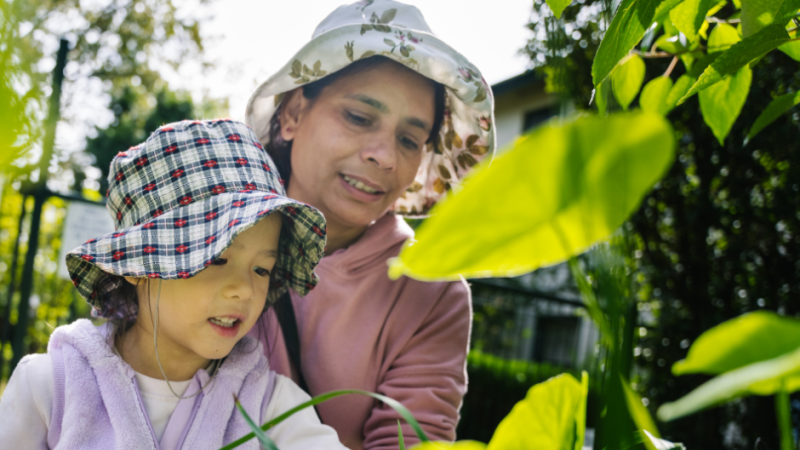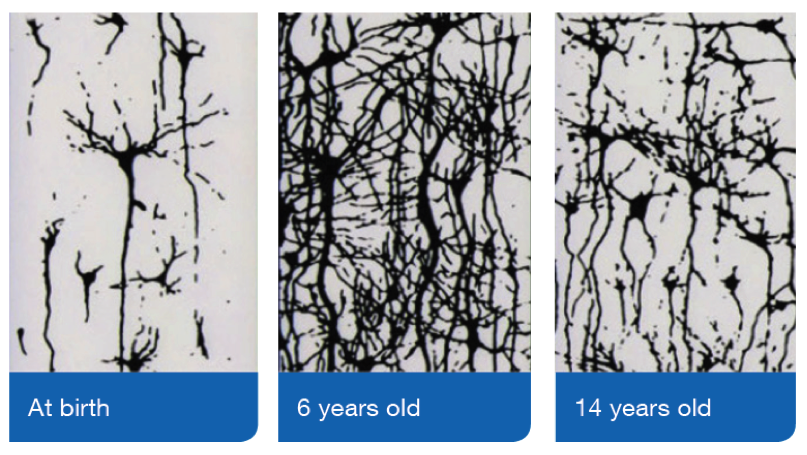
90% of a child’s brain develops by the time they’re 5 years old.
Interactions between genes and the environment shape children’s developing brains.
Families have an extremely important ongoing influence on children’s development, and community and service environments play key roles in supporting children and families during critical periods of development.
Genes provide the initial map for brain development, beginning with the basic connections in the brain from birth. Significant ‘wiring’ occurs during the first years of a child’s life and this effectively programs child development.
A 3 year old child has around 1000 trillion brain connections or synapses. In later development these are selectively pruned. A teenager’s brain has around 500 trillion synapses, and this number remains relatively stable into adulthood.
The pruning of brain synapses indicates the tremendous influence experience and environment play in shaping a young brain. It is the experiences and relationships that infants and young children have that continuously develop their brains and build the neural circuits that will be the foundation for later development.
Figure 1: The pruning trajectory of brain synapses

Positive early experiences result in optimal brain development, which in turn provides the foundation for the other skills and abilities children need for success at school and for life.
Each newly acquired skill helps in the sequential development of the next, so achieving complex and higher order skills is best supported by a good foundation.
Caring and positive relationships are important to promote resilience for babies and children. Stress is a normal part of children’s environments and when buffered by stable and supporting relationships, it can help develop positive and adaptive coping.
Excessive or long-lasting stress is known as ‘toxic stress’ and can have a negative impact on brain development. As toxic stress in the early years can damage brain development, intervening in situations where ongoing stress is likely as early as possible is critical to achieving the best possible outcomes for the child.
A child’s brain develops in different stages
The brain’s architecture of neural circuits is built in a hierarchical ‘bottom-up’ sequence. The foundation is paramount, as higher level circuits are built on lowers level ones. The table below outlines key features of early brain development from the ante-natal period to adolescence.
Key features of early brain development
Brain development period: Ante-natal
Key features:
- All five senses begin to function before birth.
- Prenatal sensory experiences actually help the brain and nervous system.
- Prenatal experiences prime the attachment behaviours of the infant.
Brain development period: 0-3 years
Key features:
- A rapid period of brain development which can be:
- fostered by relationships with caregivers, and
- supported by optimal community environments for families and children.
- Brain development is vulnerable to toxic stress (depending on length and number of stressors for the child).
Brain development period: By school age
Key features:
- Children build on the solid foundation for the first five years.
- It is more difficult for children to take advantage of the learning environment to schools if:
- they have not had optimal home environment
- there is restricted access to quality early childhood services
- they have experienced a poor quality community environment.
Brain development period: Adolescence
Key features:
- Brain development prioritises the connections used most often, resulting in the 'pruning' of the brain networks or circuits.
- As children enter this period, more intensive resources are required if children have missed the opportunities for optimal caregiving and environments in the preceding years.
There are prime times for children’s brain development
The brain is programmed for events and experiences to happen at particular times for the best wiring and brain development.
For example, language development depends on adequate hearing and if hearing loss isn’t diagnosed and the brain can’t receive the sounds that lead to language development, the language parts of the brain begin to ‘close up’.
The quality of a child’s earliest environments and the availability of appropriate experiences at the right stages of development are crucial to brain development and the foundation for learning later in life.
© 2019 Commonwealth of Australia. Since 2002, the Australian Government has worked in partnership with eminent child health research institutes, the Centre for Community Child Health, Royal Children’s Hospital, Melbourne, and the Telethon Kids Institute, Perth to deliver the Australian Early Development Census (AEDC) program to communities. The Australian Government continues to work with its partners, and with state and territory governments to implement the AEDC nationwide.